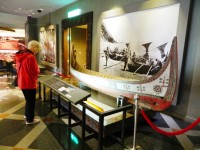In 1780, the French frigate, l’Hermione carried the Marquis de Lafayette to America with the news of French support for the American revolution. In the next month or so, the newly completed replica frigate l’Hermione will recreate that historic voyage. Here is a video of l’Hermione on sea trials last fall.
In case you missed the lunar eclipse early this morning, visible from 2AM to 6:30AM Pacific time, here is the four hour eclipse in one minute,courtesy of the Los Angeles’ Griffith Observatory. Thanks to Phil Leon for passing it along. By the way, if you grew up watching the American TV series, The Adventures of Superman, produced between 1952-1958, the “Metropolis Observatory” often featured in the program was the Griffith Observatory.
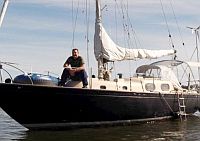
Jordan on his sailboat Angel , from an undated photo.
Reading about sailing in the media is often like reading a mystery story. The question is not, however, “who done it?” but “what really happened?” The reports of Louis Jordan who was found adrift in his disabled sailboat off Cape Hatteras after two months is a good example. Many of the press reports make no sense whatsoever. Here is my attempt to piece together what may have happened.
The story, as reported, sounds unbelievable. The Guardian reported: An American missing at sea for 66 days was rescued from his capsized boat 200 miles off the North Carolina coast, telling coastguards he survived on drinking rainwater and catching fish. Louis Jordan, 37, who was reported missing by his family in January, was spotted sitting on the overturned hull of his 35ft boat by the crew of a German tanker.” The report on Slate was similar and featured the dramatic headline: “Sailor Lost at Sea for 66 Days With Just Rainwater and Raw Fish Is Saved by Passing Tanker.” NBC Reports that Jordan was “found floating on the overturned hull of his vessel by a German cargo ship, according to the U.S. Coast Guard.”
When I say the account sounds unbelievable, I mean that literally. Continue reading
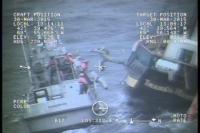 On Monday, the US Coast Guard rescued nine crew members from the schooner, Liana’s Ransom, off the coast of Maine, after the schooner suffered engine failure and her sails became fouled. There are now reports that the schooner also lost her main mast. If so, this would be the second time that the schooner has been dismasted in just the last three months. On the previous Friday, the schooner left a shipyard where repairs had been made to damage from the first dismasting.
On Monday, the US Coast Guard rescued nine crew members from the schooner, Liana’s Ransom, off the coast of Maine, after the schooner suffered engine failure and her sails became fouled. There are now reports that the schooner also lost her main mast. If so, this would be the second time that the schooner has been dismasted in just the last three months. On the previous Friday, the schooner left a shipyard where repairs had been made to damage from the first dismasting.
 Dalniy Vostok, a Russian freezer trawler, has sunk in the Sea of Okhotsk off the Kamchatka peninsula. Of the 132 people aboard, 56 are reported to have died, while 13 remain missing. Sixty-three people were rescued. The trawler sank quickly at around 06:30 local time (20:30 GMT Wednesday) after flooding was reported in the engine room. The ship sank without sending a distress call. Seventy-eight of those on board were Russian and 42 were from Myanmar. The remainder were from Vanuatu, Latvia and Ukraine. Thanks to Phil Leon for contributing to this post.
Dalniy Vostok, a Russian freezer trawler, has sunk in the Sea of Okhotsk off the Kamchatka peninsula. Of the 132 people aboard, 56 are reported to have died, while 13 remain missing. Sixty-three people were rescued. The trawler sank quickly at around 06:30 local time (20:30 GMT Wednesday) after flooding was reported in the engine room. The ship sank without sending a distress call. Seventy-eight of those on board were Russian and 42 were from Myanmar. The remainder were from Vanuatu, Latvia and Ukraine. Thanks to Phil Leon for contributing to this post.
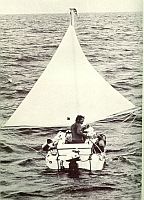
Hugo Vihlen sailing April Fool
On April 1, often referred to as April Fool’s Day, it seems fitting to recount the voyage of Hugo Vihlen in his micro-yacht April Fool. In 1966, Hugo Vihlen sailed from Casablanca to Florida, aboard his 5’11” sailboat. In 84 days he sailed 4,100 miles and got within 6 miles of Miami, Florida before being stopped by contrary winds and current. He was finally picked up by the US Coast Guard.
The micro-yacht April Fool now resides at the International Small Craft Center at The Mariners’ Museum in Newport News, VA. Their web page features excerpts from Vihlen’s book, “April Fool or, How I sailed from Casablanca to Florida in a Six-Foot Boat.” My favorite is from June 9, 1968 after 71 days at sea:
“Catastrophe. I ran out of toilet paper today. Thank God for Reader’s Digest.”
This log entry may point out an unexpecting shortcoming of ebooks on longer voyages.
A short video providing a glimpse of life aboard TeeKay’s Aframax tanker European Spirit.
 From May 20 — May 26 an estimated 1,500 Navy sailors, Marines and Coast Guardsmen will visit New York City in celebration of Fleet Week New York. Which ships will participate and what events are planned for them have not yet been announced. Watch this space.
From May 20 — May 26 an estimated 1,500 Navy sailors, Marines and Coast Guardsmen will visit New York City in celebration of Fleet Week New York. Which ships will participate and what events are planned for them have not yet been announced. Watch this space.
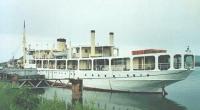 Last week we posted that the Working Harbor Committee is sponsoring the showing of a wonderful documentary on the MV Liemba, an ex-German warship, a minor movie star, and also, at one hundred years old, the world’s oldest passenger ferry in service. The documentary will be shown at 6PM tomorrow evening, Tuesday, March 31, at the Community Church of New York, 40 East 35th Street (btwn Madison & Park) New York, NY 10016.
Last week we posted that the Working Harbor Committee is sponsoring the showing of a wonderful documentary on the MV Liemba, an ex-German warship, a minor movie star, and also, at one hundred years old, the world’s oldest passenger ferry in service. The documentary will be shown at 6PM tomorrow evening, Tuesday, March 31, at the Community Church of New York, 40 East 35th Street (btwn Madison & Park) New York, NY 10016.
After the documentary James Wong, Director of Ferries, NYC Economic Development Corp and I will will be discussing ferries. I am looking forward to hearing more about the new planned expansion of ferry service in New York harbor. If you are in neighborhood and can make it, please stop by and say hello. Click here to learn more:
Surf photographer Ray Collins recently released a series of amazing photographs of ocean waves. Below is a short video of of the photographs and how he captured the amazing shots.
 Here is a reminder just how difficult it is to fund, build, operate and maintain historic or replica ships. Those who do so successfully, deserve more credit than they receive. The Irish Examiner recently described how the replica “famine ship” Jeanie Johnson has fallen on hard times. The replica is described as “haemorrhaging money” and in dire need of repair. The ship was intended to serve as a sail training ship and as a living history museum on 19th century emigration. Because of her condition, she cannot leave the dock and she is not attracting significant numbers of visitors as a dockside attraction. Construction of the three masted barque originally cost Irish taxpayers €14 million.
Here is a reminder just how difficult it is to fund, build, operate and maintain historic or replica ships. Those who do so successfully, deserve more credit than they receive. The Irish Examiner recently described how the replica “famine ship” Jeanie Johnson has fallen on hard times. The replica is described as “haemorrhaging money” and in dire need of repair. The ship was intended to serve as a sail training ship and as a living history museum on 19th century emigration. Because of her condition, she cannot leave the dock and she is not attracting significant numbers of visitors as a dockside attraction. Construction of the three masted barque originally cost Irish taxpayers €14 million.
In August we posted about Rocking the Boat, an after-school program in the Hunts Point section of the Bronx, a borough of New York City, which has been teaching neighborhood kids to build wooden boats for the last 15 years. Urban Boatbuilders offers a similar program which teaches boat building to youth in the St.Paul/Minneapolis area. Urban Boatbuilders is now a finalist in the Building Community Award. If they win, the program will receive a $62,000 grant. All it takes is votes, which cost nothing but a moment of your time. If you have a moment click here to vote for a good cause.
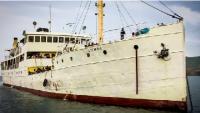 If you happen to be near New York City next Tuesday night, March 31st, be sure to stop by the Community Church to “take an epic journey down the longest lake in the world on Africa’s last surviving steamship…. the MV Liemba,” and all without leaving midtown Manhattan.
If you happen to be near New York City next Tuesday night, March 31st, be sure to stop by the Community Church to “take an epic journey down the longest lake in the world on Africa’s last surviving steamship…. the MV Liemba,” and all without leaving midtown Manhattan.
The Working Harbor Committee is sponsoring the showing of a wonderful documentary on the MV Liemba, an ex-German warship, a minor movie star, and also, at one hundred years old, the world’s oldest passenger ferry in service. The venerable ship provides a critical link to the isolated ports along the eastern shore of Lake Tanganyika. (See our post from last November, MV Liemba — the World’s Oldest Passenger/Cargo Steamer at 100 .) A trailer for the documentary appears below the page break.
From their announcement:
Before there was the African Queen, before there was the East River Ferry and the NYC Ferry plan, there was Liemba! A ferry connecting communities and people with work on the great Lake Tanganyika. Come see this warming and entertaining documentary about the 100 year old vessel; its history, interviews with the people who run and use it; and hear the marvelous sound track of East Africa music.
Special guest speaker: James Wong, Director of Ferries, NYC Economic Development Corp.
We are very pleased to have a guest post from Joan Druett, who recently visited Taiwan. Joan is the multi-award winning author of more than 20 books, including her latest, Lady Castaways and Eleanor’s Odyssey.
A priority for anyone from the Pacific who visits Taiwan is the Shung-Ye Museum of Formosan Aborigines. After all, it is now both scientifically and popularly believed that the greatest migration of seafarers in history — the discovery and settlement of the islands of the Pacific — began in Taiwan. It was from the east coast of this mountainous island off the coast of mainland China that the people we now call Polynesians set out on their epic voyages. Our New Zealand Maori are distant cousins of the Formosan Aborigines, with a great deal in common, both in appearance and in personality. There are echoes of the local language in Maori te reo.
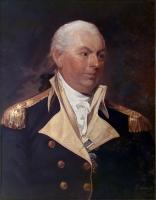
John Barry by Gilbert Stuart 1801
This seems like a good day to celebrate birthdays. So, happy birthday to Commodore John Barry, born on this day in 1745, in Tacumshane, County Wexford, Ireland. He is considered by many to be the “father of the United States Navy.” But wait, isn’t John Paul Jones also considered to be the “father of the United States Navy?”
As the saying goes, success has many fathers. Over the years, the birthday of the US Navy has been celebrated on at least four different dates. Likewise five different cities and towns lay claim to its birthplace. So, perhaps it is not surprising that the Navy has more than one candidate as father.

Mark & Scott Kelley
In January 2011, we posted about Mark and Scott Kelly, two “starship sailors” — identical twin brothers who both graduated from merchant marine academies and went on to be astronauts in the US space program. Now, Scott Kelly is about to embark on a marathon, year long voyage on the International Space Station, while his brother Mark will remain on the ground, yet will still play an important role in the mission.
Identical twins, Mark and Scott were raised in New Jersey and both attended merchant marine academies. Mark graduated from United States Merchant Marine Academy at Kings Point, NY, while Scott is a graduate of the State University of New York Maritime College at Fort Schuyler, only a few miles across Long Island Sound from Kings Point. Both served as naval aviators and then became astronauts. They are the only siblings and the only twins to ever have flow in space.
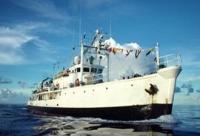
Calypso in better days
We posted recently that Jacques Cousteau’s famous research vessel, Calypso, might be in danger of being sold or scrapped. The Calypso, however, may have a savior in Prince Albert II of Monaco.
After a long legal battle, a French court ordered Francine Cousteau, the second wife of the late Jacques Cousteau, to settle outstanding yard bills and remove the RV Calypso from a Brittany shipyard by March 13. If she failed to do so, the shipyard would be allowed to sell the 43 meter wooden research vessel. Apparently for the last several months talks have been underway between the Cousteau Society and the Prince Albert II of Monaco Foundation. The Prince is said to be interested in acquiring scientific and educational material of the famous French oceanographer, consisting in movies, books, photos including the ship Calypso.
If the ship is brought to Monaco, it will be something of a homecoming. Jacques Cousteau served as the director of the Oceanographic Museum of Monaco for more than three decades, from 1957 to 1988. The Calypso was featured in Cousteau’s books and the award winning documentary “Silent World” as well the American TV series “The Undersea World of Jacques Cousteau” which ran from 1968 to 1975. Thanks to Erik Abranson for pointing out the news on the MarHistList.
Maneuvering a square-rigged ship can be a highly choreographed performance requiring both skill and timing. Here is a well done video of the 1883 built Star of India tacking and wearing.
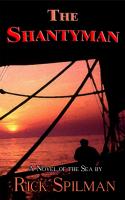 David Hayes recently reviewed The Shantyman on his Historic Naval Fiction blog. Reposted with permission.
David Hayes recently reviewed The Shantyman on his Historic Naval Fiction blog. Reposted with permission.
If you want to be taken to the deck of a clipper in the mountainous seas of a southern ocean gale, Rick Spilman is the author for you. His description of life at sea in such vessels are vivid and bring to life the conditions faced by the officers and crew of such vessels.
In his latest book, The Shantyman, he tells the story of one such crew, on the Alhambra, voyaging from Sydney to New York in 1870. Jack Barlow is hoisted aboard paralytic drunk but proves to be not just an able shantyman, but when the captain dies and the murderous mate is washed overboard, the man who will pull the crew together and as the new captain get them home. Facing the southern ocean ice and later a hurricane, he overcomes his tragic past to get them to safety and restart his life.
Successful, tragedy strikes again, but will the crew he has saved now rally round and manage to save him.
A fast paced and well written story of life at sea and also of New York at this time. Hard to put down and highly recommended.
 Happy first day of Spring! The arrival of the vernal equinox happens to coincide with a solar eclipse, as well as with a “supermoon,” and here on the west bank of the Hudson River, a snowstorm designated “Winter Storm Ultima.” (Let us hope the name “Ultima” is as in, “last or final.”) A very busy day, indeed. I would have been happy just settling for warm winds and blue skies.
Happy first day of Spring! The arrival of the vernal equinox happens to coincide with a solar eclipse, as well as with a “supermoon,” and here on the west bank of the Hudson River, a snowstorm designated “Winter Storm Ultima.” (Let us hope the name “Ultima” is as in, “last or final.”) A very busy day, indeed. I would have been happy just settling for warm winds and blue skies.
The solar eclipse is expected to be visible in parts of Northern Europe today, although there have been reports of cloudy skies which may obscure some of the better vantage points. Clouds are not the only concern. Yesterday, a Czech tourist who was camping on the remote Arctic island of Svalbard in order to watch the solar eclipse, was dragged out of his tent by a polar bear. Fortunately, the bear was driven off and the Czech’s injuries were reported not to be life-threatening.

